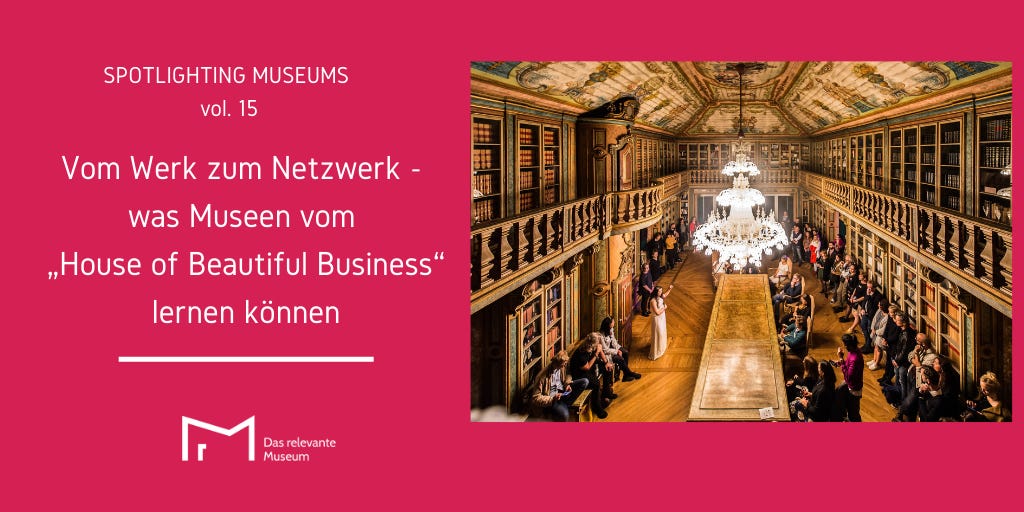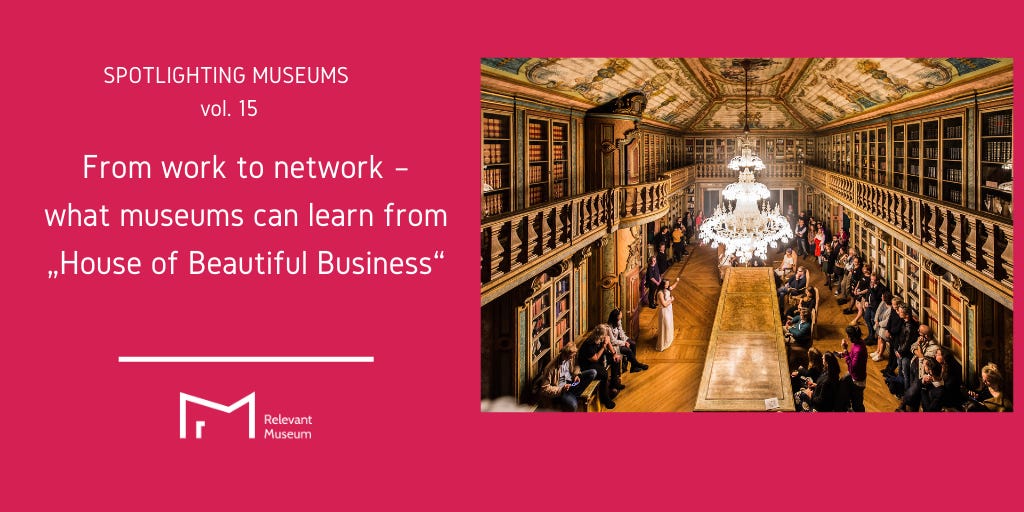Spotlighting Museums, vol. 15
Vom Werk zum Netzwerk - was Museen vom „House of Beautiful Business“ lernen können - From work to network – what museums can learn from „House of Beautiful Business“
Please find the English version below
Sommerlich begrüßen wir Sie zur neuen Ausgabe. An einem der längsten Tage des Jahres sind wir in die Kunst des Netzwerk-Kuratierens eingetaucht.
Doch bevor wir skizzieren, was unseren Gast, das „House of Beautiful Business“, auszeichnet, möchten wir hervorheben, wie sehr wir es schätzen, mit welcher großen Offenheit und Entschlossenheit Teams aus 15 Museen und zwei Stiftungen gemeinsam Neues betrachten, Pros und Kontras äußern, den Blick justieren und bereit sind, trotz möglicher Vorbehalte ungewohnte Formate auszuprobieren.
Museen neu denken – das ist die Idee für das Programm, das Dirk von Gehlen für „Das Relevante Museum 2022“ kuratiert. Wie neue Narrative für Museen in einer Ökonomie der Aufmerksamkeit aussehen könnten, zeigte bei der zweiten Sitzung des Programms Till Grusche, der als Co-Founder und Co-CEO das „House of Beautiful Business“ aufgebaut hat.
Das Besondere dabei: Dieses Haus hat gar keinen physischen Ort. Es handelt sich bei der „Business Romantic Society“, die Grusche gemeinsam mit Tim Leberecht leitet, um eine Community, die im Umfeld des Web-Summit in Lissabon entstand.
Grusche zeigte den Teilnehmerinnen und Teilnehmern des „Relevanten Museums“ nicht nur die Grundidee seines Projekts, sondern stellte ihnen auch ein Framework vor, das seiner Ansicht nach für alle Aufmerksamkeits-Akteure gilt. Denn neben der rein inhaltlichen Ebene eines Projekts (Information) gibt es sechs weitere Faktoren, die den Erfolg einer Gemeinschaft bestimmen.
Diese sind für Grusche: Der finanzielle Faktor (Money), die Aufmerksamkeit, die dem Projekt geschenkt wird (Attention), die sozialen Interaktionen und Beziehungen (Relation), die Erfahrungen (Experience) und die sich aus diesen Aspekten ergebende Ebene der Identität (Identity).
Alle diese Faktoren schaffen einen Kontext, der den Inhalt (Content) einer Ausstellung oder eines Museums prägt.
Dirk von Gehlen stellte in der anschließenden Diskussion die These auf, dass das digitale Ökosystem eine Entwicklung begünstigt habe, die er als „Vom Werk zum Netzwerk“ beschrieb – und in deren Folge eben dieser Kontext an Bedeutung gewinne.
Dieser Kontext, greifbar im Framework von Till Grusche, entwickelt seine Relevanz stets aus der Perspektive des Nutzers bzw. der Nutzerin.
Relevanz, so die Schlussfolgerung, ist also eine relative Wechselbeziehung zwischen Museum und Publikum – und nie absolut zu denken.
Die Zeit für einen Dank nehmen wir uns hier: Den Kern der Session hat Dirk von Gehlen für unseren Newsletter zusammengefasst. Wir danken ihm und Till Grusche für die vielen Denkanstöße.
Schauen Sie gern bei „House of Beautiful Business“ vorbei:
http://houseofbeautifulbusiness.com
(29) House of Beautiful Business: Videos | LinkedIn
Voicing Relationships | House of Beautiful Business
Genussvolle Sommertage Ihnen allen
wünscht
Katja Stark, NORDMETALL-Stiftung
English Version
With summer greetings we welcome you to our new edition. On one of the longest days of the year, we dived into the art of network curating.
But before we outline what defines our guest, the "House of Beautiful Business", we would like to emphasise, how much we appreciate the openness and determination, with which teams from 15 museums and two foundations look at new things together, express pros and cons, adjust their view and are willing to test unusual formats despite pontential doubts.
Rethinking museums – that is the idea behind the programme that Dirk von Gehlen is curating for "Relevant Museum 2022". What new narratives for museums could look like in an economy of attention, was shown at the second session of the programme by Till Grusche, Co-founder and Co-CEO of "House of Beautiful Business".
What stands out: This house has no physical space at all. The "Business Romantic Society", which Grusche leads together with Tim Leberecht, is a community that was created in the context of the Web Summit in Lisbon.
Grusche not only showed the participants of the "Relevant Museum" the basic idea of his project, but also presented them a framework that applies to everyone focussing on the topic of attention. In addition to the pure content level of a project (information), there are six other factors that determine the success of a community.
For Grusche these are: The financial factor (Money), the attention given to the project (Attention), the social interactions and relationships (Relation), the experiences (Experience) and the level of identity resulting from these aspects (Identity).
All these factors create a context that designs the content (Content) of an exhibition or museum.
In the following discussion, Dirk von Gehlen puts his thesis forward, that the digital ecosystem had facilitated a development that he described as "from work to network" – and as a result of which this very context is gaining in importance.
This context, tangible in Till Grusche's framework, always develops its relevance from the perspective of the user.
Relevance, so the conclusion, is therefore always a relative interrelationship between museum and audience – and never to be thought absolutely.
We take some time for gratitude: Dirk von Gehlen summarised the core of the session for our newsletter. We thank him and Till Grusche for lots of “food for thought”.
Don’t hesitate to visit "House of Beautiful Business":
http://houseofbeautifulbusiness.com
(29) House of Beautiful Business: Videos | LinkedIn
Voicing Relationships | House of Beautiful Business
Enjoyable summer days for all of you
Katja Stark, NORDMETALL-Foundation






